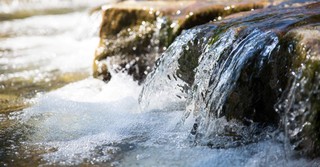What Is the Significance of the Pishon River in the Bible?
Share

What Was the Pishon River?
The Pishon River was located in Eden. “It is the one that flowed around the whole land of Havilah, where there is gold” (Genesis 2:11). In the verses immediately preceding verse 11, we discover, “a mist was going up from the land and was watering the whole face of the ground” (Genesis 2:6). Verses 7-9 describe how the Lord God formed man from the dust and planted a garden in Eden, “in the east, and there He put the man whom He had formed.”
God made every tree “that is pleasant to the sight and good for food” and placed them in the Garden of Eden.
“A river flowed out of Eden to water the garden” (Genesis 2:10). God did not name that river, but the four rivers which stem from it are designated with names. The Pishon River is the first among the four rivers named that stem from the division of the river found in the Garden of Eden. The Bible further tells us of the particular abundance found in the land the Pishon River encompassed: “…the gold of the land is good; bdellium and onyx stone are there” (Genesis 2:12).
What Do We Know about the Four Rivers in Eden?
The four rivers in Eden were the Pishon River, the Gihon, the Tigris, and the Euphrates. All sourced from the one river in the Garden (Genesis 2:10). Because rivers normally begin in upper regions and from larger bodies of water, this is unusual.
John Calvin, in his 16th-century edition of the Bishop’s Bible, invigorated the practice of placing Eden—the mouth of the four named rivers—in modern-day Iraq. Yet, even by man’s reckoning—which is always fallible—there is no sure way to locate Eden, the rivers’ source. The Bible gives us only so much information, and we must rest in its authoritative information.
The Pishon River, as stated above, “flowed around the whole land of Havilah.” This area is probably modern-day north-central Arabia, east of Israel.
The Gihon River was in Cush, perhaps the Cassite (Kassite) area in the mountains of Mesopotamia, and not Ethiopia.
If the geography as God created it remained as such, post-Flood, the Tigris and Euphrates Rivers can be identified. The Tigris River, second in length only to the Euphrates in western Asia, flows through four countries: Iran, Iraq, Turkey, and Syria. The Tigris and the Euphrates make up a river system that rims the Fertile Crescent, and both are vital sources of travel and irrigation. The Tigris now originates in Turkey’s Lake Hazer and flows parallel with the Euphrates.
In the Bible, the Tigris is again mentioned in Daniel 10:6, where beside it, Daniel saw the terrifying vision of a man with a body like “beryl, a face like the appearance of lightning, eyes like flaming torches and arms and legs like the gleam of burnished bronze, and the sound of his words like the sound of a multitude” (emphasis mine).
The Euphrates River is currently at its lowest level in years. The once-mighty Euphrates River sits in what has been described as the Cradle of Civilization. A lifeblood of the countries through which it flows, the Euphrates River, when at its peak, supplies irrigation and drinking water for the people within its range. In the Bible, the Euphrates is sometimes referenced as The River. This is for identification purposes only, since it was (and is) the longest in its area.
In Revelation 9:14, the Euphrates is noted as being the place where four angels are bound. And in Revelation 16:12, “the sixth angel poured out his bowl on the great river Euphrates, and its water was dried up, to prepare the way for the kings from the east.” So, then, the Euphrates is mentioned in the first and last books in the Bible (Genesis 2 and Revelation 16). A great river, indeed.
What Do Rivers Represent in the Bible?
In the physical realm, rivers promote life wherever they flow. Not only do they irrigate lands, but they also sustain the life of the creatures who populate them. And in turn the fish and other edibles within furnish sustenance for other animals, including man. Within each river is a complex and fascinating ecosystem the Lord appointed for it.
For the most part, the Bible uses the term, river, as a geological stream of water (Genesis 2:10-14, Exodus 2:3, Ezra 5:3, etc.).
Apart from that, in a theological sense, the term river (or rivers) sometimes serves as figurative imagery pertaining to one’s spiritual well-being.
Psalm 1:3 compares a righteous man to a tree planted by a river (streams of water) which enables him to lead a fruitful life nourished by the water of the metaphorical river. And in this sense, we can equate the river to God’s Word, from which we gain our spiritual nourishment. But we must be careful not to spiritualize a tree or a river. In this Psalm, remember, the psalmist uses like, which denotes a simile, a figure of speech used to bring further understanding of something by comparing it to another thing. It’s not the thing itself, it’s the reference.
In Revelation 12:15-17, an image of a river is once again used in a metaphorical sense with regard to the “serpent” who, “poured water like a river out of his mouth.” In verse 16, “the earth opened its mouth and swallowed the river that the dragon had poured from his mouth.”
The attributes of a river are also used in the Bible as descriptors to explain the characteristics of another occurrence, as we see in Job 14:11. Job’s soliloquy centers on how death comes to every man, and it is God who determines the months and days of everyone (Job 14:5). As a river “wastes away and dries up,” so a man dies. Job is stating a plain fact that a river sometimes dries up and is no more. It’s a comparison but not a metaphor.
Psalm 98:8 reveals the use of the term, rivers, as a personification when it says, “Let the rivers clap their hands.”
Lamentations 3:48 shows us how God uses the idea of rivers to connote a sense of overwhelming grief when Jeremiah said, “my eyes flow with rivers of tears because of the destruction of the daughter of my people.”
Micah 6:7 reads, “Will the Lord be pleased with thousands of rams, with ten thousand rivers of oil?” Here God used a literary vehicle to elucidate the magnitude of oil which could only be measured as rivers of it.
5 Important Things to Know about the Pishon River
The Pishon River is the first-named river—ever, and God named it, as He did the other three which emanated from the unnamed river in Eden.
The Pishon River most likely can be identified with the Karun River which proceeds from the highlands of Media. It formerly drained into the Persian Gulf. But no one knows for sure.
Josephus, in his Antiquities of the Jews, identified the Pishon River with the Ganges River of India.
The Pishon River did not escape man’s attempts to deify it. A mosaic identified as a representation of Pishon (a god) was found in the Church of Theodorus (ca. mid-sixth century BC).
The proper noun, Pishon, is transliterated, Pîšôn. It means increase.
A medieval French Rabbi named Rashi classified the Pishon River as being the Nile River (Egypt).
Throughout the Bible, rivers are given mention regarding historical narratives, metaphorical references, and illustrative uses. A look at how God identifies and alludes to rivers enhances our view of Him as our creative Father.
Photo credit: ©GettyImages/FCerez
